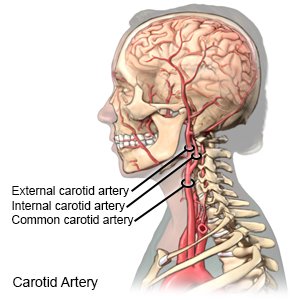Carotid Artery Stent Placement
Medically reviewed by Drugs.com. Last updated on Apr 6, 2025.
What do I need to know about a carotid artery stent placement?
A carotid artery stent placement is a procedure to widen a narrowed carotid artery. The carotid arteries are 2 large blood vessels on each side of your neck. They carry blood and oxygen from your heart to your brain. A stent is a wire mesh tube that helps hold your carotid artery open.
 |
How do I prepare for a carotid artery stent placement?
- You may need blood tests, a chest x-ray, ultrasound, or electrocardiogram (ECG) before your procedure. Talk to your healthcare provider about these or other tests you may need. You will need someone to drive you home and stay with you after your procedure.
- Your healthcare provider will talk to you about how to prepare for your procedure. He or she may tell you not to eat or drink anything after midnight on the day of your procedure. He or she will tell you what medicines to take or not take on the day of your procedure. You may need to stop taking blood thinners several days before your procedure. Ask your healthcare provider if you can continue taking aspirin.
- You may be given an antibiotic through your IV to help prevent a bacterial infection. Contrast liquid may be used during your procedure. Tell a healthcare provider if you have ever had an allergic reaction to antibiotics or contrast liquid.
Drugs used to treat this and similar conditions
Crestor
Crestor (rosuvastatin) is used to treat high cholesterol and high triglycerides in the blood ...
Plavix
Plavix (clopidogrel) is used to prevent blood clots after a recent heart attack or stroke. Includes ...
Repatha
Repatha (evolocumab) is a PCSK9 inhibitor used to lower high cholesterol alongside dietary changes ...
Xarelto
Xarelto (rivaroxaban) is a factor Xa inhibitor used to reduce the risk of blood clots and stroke in ...
Zontivity
Zontivity is used for the prevention of cardiovascular events. Includes Zontivity side effects ...
Vorapaxar
Vorapaxar systemic is used for peripheral arterial disease, prevention of atherothrombotic events ...
Rivaroxaban
Rivaroxaban systemic is used for atrial fibrillation, cardiovascular risk reduction, congenital ...
Rosuvastatin
Rosuvastatin is a prescription medication used to treat high cholesterol and prevent heart disease ...
Isoxsuprine
Isoxsuprine systemic is used for cerebrovascular insufficiency, coronary artery disease, raynaud's ...
Clopidogrel
Clopidogrel systemic is used for acute coronary syndrome, acute coronary syndrome, prophylaxis ...
What will happen during a carotid artery stent placement?
- You may be given general anesthesia to keep you asleep and free from pain during your procedure. You may instead be given IV sedation to make you feel calm and relaxed during the procedure. You may also be given local anesthesia to numb the area. With local anesthesia, you may still feel pressure or pushing but you should not feel any pain.
- Your healthcare provider will insert a catheter and wire into a blood vessel in your arm, wrist, or groin. He or she will move a wire through the catheter and up into your carotid artery. Your healthcare provider may inject contrast liquid so he or she can see your carotid more clearly on the x-ray. You may feel warm when the contrast liquid is injected. Your provider may use a balloon to help open your carotid artery. A stent will be inserted through the catheter and into your carotid artery.
- Your healthcare provider will remove the catheter. He or she may use clamps, stitches, or other devices to close the wound. Pressure will be applied to the wound for several minutes to stop any bleeding. A pressure bandage or other pressure device may be placed over the wound to help prevent more bleeding.
What will happen after a carotid artery stent placement?
- You will be attached to a heart monitor until you are fully awake. A heart monitor is an EKG that stays on continuously to record your heart's electrical activity. Healthcare providers will monitor your vital signs and pulses in your arm or leg. They will frequently check your pressure bandage for bleeding or swelling.
- You will need to lie flat with your leg or arm straight for 2 to 4 hours. Do not get out of bed until your healthcare provider says it is okay. Arm or leg movements can cause serious bleeding. You will need to stay in the hospital overnight. Healthcare providers will continue to monitor your heartbeat, blood pressure, and wound.
What are the risks of a carotid artery stent placement?
You may bleed more than usual or get an infection. You may have bruising or pain where the catheter was. You may need surgery to repair damages from the catheter to your blood vessels or stop bleeding. You may get a blood clot in your arm or leg. You could have a heart attack or stroke during or after the procedure. You may have an irregular heartbeat during the procedure. The contrast liquid may cause kidney damage or an allergic reaction.
Care Agreement
You have the right to help plan your care. Learn about your health condition and how it may be treated. Discuss treatment options with your healthcare providers to decide what care you want to receive. You always have the right to refuse treatment. The above information is an educational aid only. It is not intended as medical advice for individual conditions or treatments. Talk to your doctor, nurse or pharmacist before following any medical regimen to see if it is safe and effective for you.© Copyright Merative 2025 Information is for End User's use only and may not be sold, redistributed or otherwise used for commercial purposes.
Further information
Always consult your healthcare provider to ensure the information displayed on this page applies to your personal circumstances.
